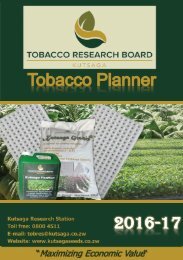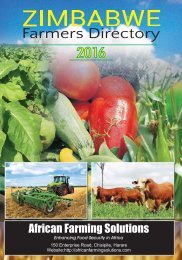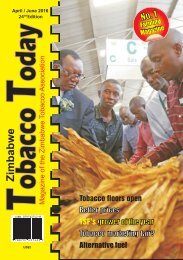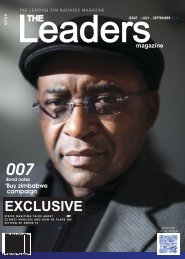livestock
Create successful ePaper yourself
Turn your PDF publications into a flip-book with our unique Google optimized e-Paper software.
LIVESTOCK<br />
April - June 2016<br />
$2.00<br />
Draught update<br />
Draught update<br />
ZFPA Launch<br />
65 Years of<br />
Mashona Cattle<br />
Livestock and Meat<br />
Advisory Council<br />
& its allied associations
BAIN
LIVESTOCK<br />
A Magazine for Livestock and Meat Advisory Council & its allied associations<br />
April - May 2016<br />
CONTENTS<br />
Editorial – Taking stock 4<br />
Drought update 6<br />
ZFPA launch 7<br />
Quail 9<br />
65 years of Mashona cattle 11<br />
Growing hides' stockpile 14<br />
Bread, bran and the bigger picture 15<br />
Cover<br />
9<br />
LIVESTOCK<br />
Published by Mediaserv Advertising & Marketing<br />
14-15 Bain Centre<br />
King George Road, Avondale, Harare<br />
04-336620/68, 0772 623 780<br />
Advertising: Chris Kaitano 0772 295 191,<br />
mediaservad@gmail.com<br />
Editor: Jill Day, 0772 224 165, jillrday@zol.co.zw<br />
Designer: Obert Nziraona, 0777 101 788, onziraona@yahoo.com<br />
Published on behalf of the Livestock and Meat Advisory Council and<br />
its allied associations, Exhibition Park, S. Machel Ave, Harare<br />
04-756600/777391. admin@lit.co.zw<br />
Views expressed in this publication do not necessarily reflect the<br />
opinions of LMAC or Mediaserv. All material is copyright.<br />
Livestock and Meat Advisory Council & its allied associations
Editorial<br />
A Magazine for Livestock and Meat Advisory Council & its allied associations<br />
Taking Stock<br />
G<br />
overnment' recent landmark Agency (DANIDA) funded Smallholder<br />
decision to recognise Livestock (Beef) Sub-Sector Study carried<br />
aquaculture as part of out by the Netherlands Development<br />
agriculture has paved the way for fish Agency (SNV).<br />
farming's expansion in Zimbabwe. It is Two-thirds of the national herd is now<br />
now a <strong>livestock</strong> industry in its own right concentrated in the communal sector,<br />
under the ambit of the ministry of where cattle are kept for multiple<br />
agriculture, mechanization and purposes and offtake is generally low. In<br />
irrigation development. some rural communities, offtakes of up at grassroots level to evolve into a unitary<br />
Other new <strong>livestock</strong> entities have been to 13% over the last decade have been association.<br />
established, reflecting growing interest in recorded, almost reaching the 15% Strong farmer associations and<br />
the commercial rearing of different types offtake target set by government to grow organisational structures at the macro<br />
of stock for sustainable livelihoods and the beef industry. level are vital to give cohesion, direction,<br />
self-empowerment. The Rabbit Breeders Recognising the strong dairy farmer engagement and professionalism when<br />
and Producers Trust and the Zimbabwe organisation in the country, the study serving the interests of <strong>livestock</strong><br />
Quail and Aviculture Association have observes that the Zimbabwe Association producers at all levels. Well organised,<br />
recently been launched and a large of Dairy Farmers plays a critical role in member-owned associations deliver on<br />
number of participants attended the providing technical extension, lobbying their mandate and give farmers a unified<br />
events. and engagement and information voice to engage other stakeholders on<br />
I n l i n e w i t h t h e s e e x c i t i n g transfer to dairy farmers. issues fundamental to the business of<br />
developments, the annual Livestock The workshop to validate the findings farming.<br />
Symposium in May will also include fish, of the SNV Beef Sub-Sector Study This is especially important in a year<br />
quails and rabbits. This event provides a i d e n t i f i e d a n e e d f o r s t r o n g when many <strong>livestock</strong> producers are<br />
learning and experience sharing forum organisational structures to build farmer fighting for survival--with some now<br />
for <strong>livestock</strong> producers across the capacity in the beef sector. Noting the losing up to four cattle a day to drought.<br />
spectrum. many initiatives to improve the There is a need for drought mitigation<br />
That Zimbabwe's largest group of livelihoods of cattle owners at the micro, measures, for strategic planning and to<br />
<strong>livestock</strong> producers, cattle owners, do meso and macro levels, the study use available resources to help people<br />
not have an association of their own to emphasises the need for a strong beef survive as well as to save <strong>livestock</strong>.<br />
represent their interests is highlighted in producer organisation—whether So who's going to look after our<br />
the Danish International Development established as a national entity or initially interests then?<br />
4<br />
Livestock Today April-June 2016
A Magazine for Livestock and Meat Advisory Council & its allied associations<br />
6<br />
Livestock Today April-June 2016
F<br />
ish farming is a <strong>livestock</strong><br />
enterprise in its own right and<br />
must be developed into a fullyfledged<br />
agricultural industry in<br />
Zimbabwe. This was highlighted at the<br />
launch of the Zimbabwe Fish<br />
Producers' Association (ZFPA) at<br />
Exhibition Park on March 17, which<br />
attracted a turnout of 206, eager to<br />
find out more about fish production.<br />
The formation of ZFPA under the<br />
umbrella of LMAC brings aquaculture<br />
formally into agriculture as part of the<br />
<strong>livestock</strong> sub-sector.<br />
The establishment of ZFPA comes as freshwater fish farm in Africa but less for human consumption. Aquaculture<br />
Zimbabwe works to develop a fish than 5% of the 400,000 hectares is a form of commercial farming that is<br />
capacity building strategy, under the suitable for inland aquaculture are non-consumptive in its use of water<br />
EU-funded SmartFish programme. In a being used for fish production. and can be integrated into crop<br />
project co-implemented by FAO, OIC Currently concentrated in commercial production or other <strong>livestock</strong> farming.<br />
SmartFish is working with the ministry tilapia operations on Lakes Kariba, Fish farming has an important role to<br />
of agriculture, mechanization and Chivero and Darwendale and rainbow play in Zimbabwe, in drought<br />
irrigation to develop the country's trout farming around Nyanga, mitigation, agricultural production for<br />
aquaculture potential, so that a q u a c u l t u r e r e m a i n s l a r g e l y sustainable livelihoods and food<br />
Zimbabwe can also reap the benefits undeveloped. security, as well as contributing to<br />
of the global Blue Revolution.<br />
economic development through<br />
“Fish farming in Zimbabwe is still in its processed fish exports.<br />
Aquaculture—the world's fastest infancy,” Gerry McCollum, chairman Aquaculture is the fastest growing<br />
growing food industry—can be of ZFPA noted at the launch of the agricultural industry globally.<br />
developed into a major industry in association. “Fish is an industry that Fish have the highest food conversion<br />
landlocked Zimbabwe at both small- people can get involved in and realise ratios - they produce more protein per<br />
and large-scale levels. The country the enormous potential that exists for kg of feed.<br />
holds 60% of all dammed water in the fish farming here in Zimbabwe.<br />
SADC region and boasts the largest<br />
To assist small-scale farmers to enter<br />
“We have fabulous water resources the industry, ZFPA is working to make<br />
and perfect climatic conditions for fish all the required inputs and services<br />
farming. We have all the inputs, the accessible to farmers in one package.<br />
right feed to grow fish commercially “We plan to roll out the same model as<br />
and we need to take advantage of this the one used in the broiler industry, so<br />
to grow aquaculture into a strong and as to support small-scale producers<br />
burgeoning industry in Zimbabwe.” with a full package of inputs and to<br />
provide farming advice,” explains<br />
Government is ready to partner the Gerry McCollum.<br />
new ZFPA to ensure the success of fish<br />
farming in Zimbabwe, guest speaker, The vision to grow aquaculture in<br />
Eng. Ringston Chitsiko, permanent Zimbabwe will focus on developing<br />
secretary in the ministry of agriculture fish farming in areas with greatest<br />
mechanization and irrigation, said at production and marketing potential,<br />
the launch. By recognising that fish are greater use of the abundant water<br />
<strong>livestock</strong>, to be farmed commercially resources and growing commercial<br />
for food production and not just smallholder aquaculture in the country.<br />
conserved in their wild state for Where there are no water bodies, there<br />
capture, government has classified is scope for pond construction, the<br />
aquaculture as part of the <strong>livestock</strong> basis of commercial smallholder fish<br />
sub-sector.<br />
farming in Asia.<br />
Fish can be farmed intensively; they are<br />
efficient converters of feed into protein<br />
A Magazine for Livestock and Meat Advisory Council & its allied associations<br />
ZIMBABWE FISH PRODUCERS' ASSOCIATION LAUNCH<br />
- bringing aquaculture into agriculture<br />
Picture Courtesy of African Fisherman<br />
Picture Courtesy of African Fisherman<br />
Malachite bream<br />
In the warmer areas of Zimbabwe, not<br />
as well suited to other forms of<br />
Livestock Today April-June 2016 7
agriculture, fish can be<br />
introduced as an alternative form<br />
o f c o m m e r c i a l f a r m i n g .<br />
A q u a c u l t u r e c a n p l a y a<br />
complementary role in the fish<br />
industry too, augmenting<br />
livelihoods of capture fisherman<br />
whose catches have been steadily<br />
declining over the last decade.<br />
A Magazine for Livestock and Meat Advisory Council & its allied associations<br />
Bringing aquaculture into agriculture<br />
continued from page ...7<br />
The ministry of agriculture,<br />
mechanization and irrigation is<br />
developing an aquaculture<br />
capacity building programme for<br />
Zimbabwe, with technical<br />
assistance from SmartFish and<br />
FAO<br />
Calling on Zimbabwe to emulate<br />
ZFPA is working to develop a<br />
the example of some other<br />
regulatory framework for<br />
African countries, SmartFish<br />
aquaculture in Zimbabwe, one of<br />
Programme fisheries and<br />
Picture Courtesy of African Fisherman<br />
the few countries in Africa that<br />
aquaculture advisor, Dr Blessing<br />
does not yet have one, and to suited to high stocking in dams and Mapfumo, told the ZFPA launch<br />
harmonise all legislation relating to ponds. Another key development is gathering: “Fish production requires<br />
fish and aquaculture. “We also need the Aquaculture Quality Control the creation of an enabling<br />
to establish production standards and Laboratory in Harare, to be equipped environment.” The continent's top six<br />
benchmark with other countries,” says with EU funding under the SmartFish fish producers, Namibia, Zambia,<br />
Gerry McCollum. programme. In a programme of Kenya, Ghana, Uganda and South<br />
technical assistance to Zimbabwe Africa, have invested in aquaculture<br />
The development in Zimbabwe of a started in 2012, SmartFish has development with stimulus policies<br />
specialised fish feeds' industry in provided training in aquaculture, and development programmes that<br />
recent years has improved tilapia v a l u e c h a i n a n d b u s i n e s s are building strong aquaculture<br />
growth rates for the commercial development support, as well as trade industries in these countries.<br />
farming of Africa's indigenous fish, and marketing studies and promotion.
A Magazine for Livestock and Meat Advisory Council & its allied associations<br />
These indigenous birds are productive, producing eggs<br />
said to have twice the nutritional value of hen's ones and<br />
they are quick to market.<br />
C<br />
apital Foods' launched its first clutch were males.<br />
quail feed to a capacity Nevertheless her flock<br />
crowd at the Andy Millar grew but the biggest<br />
Hall in Harare's Exhibition challenge was the<br />
Park on January 30.<br />
feed.<br />
Quail<br />
These indigenous birds are productive, Capital Foods have<br />
producing eggs said to have twice the solved this particular<br />
nutritional value of hen's ones and they problem with a new<br />
are quick to market. Their meat, similar range of balanced<br />
to chicken, is said to give the grey nutrition for the birds<br />
generation the energy to face another at various stages, plus<br />
day: they are certainly a good source of a costing model so<br />
protein.<br />
people can budget<br />
correctly.<br />
Mrs Woloza started farming quail three<br />
years ago. She started with 50 birds It produces a layers'<br />
and said they are easy to breed—but mash that is 24%<br />
hard to sex and three-quarters of her protein. This reduces<br />
to 10% protein after<br />
three to four weeks.<br />
After six or seven<br />
Quail eggs contain twice the goodness of hens' ones.<br />
weeks they move onto a finishing diet “To move from the office to raising<br />
so they no longer lay. The broiler food quail was difficult but thanks to this little<br />
contains 18% protein.<br />
bird, my family manages to eat and to<br />
pay school fees. If we are good to these<br />
“We did not vaccinate and somehow birds, they will look after you.”<br />
they did not die,” Mrs Woloza said.<br />
“We also did not know how long to Capital Foods also launched feed for<br />
incubate the eggs but we managed. roadrunners. With the worldwide move<br />
The biggest question was: 'Who is the to organic food, the price of<br />
market?' I can tell you: we are the r o a d r u n n e r s i s i n c r e a s i n g<br />
market. It is a sweet bird and, like all exponentially, so this is a good market<br />
Quail, an indigenous bird now<br />
meat, it is important to eat it fresh. to investigate as well.<br />
being intensively farmed.<br />
Would-be quail farmers crammed the Andy Millar hall to find out how to raise these wild birds.<br />
Livestock Today April-June 2016 9
A Magazine for Livestock and Meat Advisory Council & its allied associations<br />
Mashona Cattle Society marks 65 proud years<br />
- AS THE MASHONA IS PROPOSED AS ZIMBABWE'S BASELINE BREED<br />
O<br />
nce scorned for their small<br />
size, Zimbabwe's Mashona<br />
cattle are today recognised<br />
as one of the world's most productive<br />
and resilient bovines. This unique<br />
indigenous breed—saved by the<br />
Mashona Cattle Society from genetic<br />
dilution 60 years ago—is to be<br />
adopted as Zimbabwe's baseline cattle<br />
breed.<br />
“More than ever, we recognise the<br />
value of the little Mashona as we<br />
experience the effects of climate<br />
change,” Joseph Sikosana, director of<br />
Livestock and Pastures Research in the<br />
Department of Research and Specialist<br />
Services told the 65th AGM of the<br />
Mashona Cattle Society in December<br />
2015.<br />
Adapted over thousands of years to efficient conversion of grass to beef and Ranch, one of the largest commercial<br />
the harsh African environment, the also in the dairy industry to boost beef enterprises there, Mashona have<br />
Mashona has been genetically production fo r n ational milk sufficiency. outperformed other breeds over the<br />
improved for greater productivity by This breed is proving its worth in other last five years, achieving a 98%<br />
Mashona cattle breeders working in African countries too. pregnancy rate against the ranch<br />
conjunction with the Zimbabwe Herd “On-farm results from Mozambique average of 57%. The Dombe Mashona<br />
Book (ZHB). show that Mashona are still the most Herd is the highest performing herd on<br />
The Mashona breed has a significant productive cattle on veld”, MCS veld grazing in Mozambique,<br />
role to play in farming today—in chairman Dr Doug Bruce told the surpassed only by cows on pasture.<br />
climate mitigation strategies, society 's 2015 AGM. On Dombe<br />
continued on page ...11<br />
Livestock Today April-June 2016 11
A Magazine for Livestock and Meat Advisory Council & its allied associations<br />
Mashona Cattle Society marks 65 proud years<br />
continued from page ...9<br />
Twenty years on, this corroborates the Zimbabwe's Mashona breed has also The Indibreed Group Breeding<br />
results of Zimbabwe's most extensive attracted interest in the United States, Scheme, operated by the society for 10<br />
cattle breed comparison trial at w h e r e t h e e m p h a s i s h a s ye ar s, w as established to speed up<br />
Matopos Research Station in the traditionally been on breeding larger Mashona genetic selection and forms a<br />
1990s, where the Mashona was animals. Crossbreeding work in New nucleus herd; in a scheme also<br />
unrivalled on natural veld. During “the Mexico has shown that Mashona cross designed to feed improved stock back<br />
worst drought in living memory” in steers were the only animals to turn a into communal herds for genetic<br />
1992, it was evident that the Mashona profit on natural grassland with no improvement.<br />
were able not only to survive adverse supplements. In meat analysis tests, this<br />
conditions but to produce a calf again “true grass breed” scored a high Today, working in conjunction with<br />
the following year. flavour rating and showed good ZHB, Zimbabwe's Mashona cattle<br />
marbling.<br />
breeders continue to improve the breed<br />
“Kilogram for kilogram, Mashona<br />
for greater productivity and resilience<br />
cattle will give more kilos of calf, per In Zimbabwean cattle research and under climate change—one of the<br />
kilo of cow put to the bull,” notes Dr evaluation, the adoption of the greatest challenges to global<br />
Bruce. On the role that the Mashona Mashona as the baseline breed is a agriculture.<br />
can play in the dairy industry today, the proud achievement for the MCS, which<br />
MCS chairman says. “We can in 1968 initiated the first research work - From the Mashona Cattle Society.<br />
crossbreed for hybrid vigour, with sexed on indigenous cattle<br />
dairy semen to produce hardy, good in the country to<br />
milkers for communal farmers.” demonstrate that<br />
indigenous cattle<br />
The MCS has also devised a breeds can also be<br />
programme to help interested small- genetically improved<br />
scale farmers to become fully w i t h s e l e c t i v e<br />
registered pedigree breeders. In this breeding. In the<br />
open appendix system, new breeders 1960s and 70s the<br />
can register with the Zimbabwe Herd society campaigned<br />
Book (ZHB) and work with the MCS to to save the Mashona<br />
upgrade their foundation Mashona breed from genetic<br />
cows to fully registered stud animals dilution in a massive<br />
over three generations.<br />
A .I. programme<br />
intended to improve<br />
The value of Zimbabwe's Mashona all communal cattle<br />
breed is well recognised today. It is with exotic cattle<br />
understood that the Mashona's small genes, a misguided<br />
size is part of its survival mechanism, policy.<br />
evolved over thousands of years for<br />
productive efficiency under harsh To make best use of<br />
environmental conditions. These Zimbabwe's fine<br />
include heat tolerance, resistance to cattle heritage, new<br />
ticks, flies and parasite infestation, high Mashona genetics in<br />
fertility and reproductive efficiency, a the communal herd<br />
lower maintenance requirement as well must be identified to<br />
as foraging ability and strong teeth for broaden the gene<br />
optimum utilization of the veld and pool for breeding, a<br />
efficient conversion of grass into beef process begun by the<br />
or milk. MCS in the 1990s.<br />
Livestock Today April-June 2016 13
A Magazine for Livestock and Meat Advisory Council & its allied associations<br />
G<br />
rowing<br />
GROWING STOCKPILES OF HIDES<br />
stockpiles of<br />
hides at<br />
Zimbabwe's - Rethinking the export of hides and skins<br />
abattoirs highlight the<br />
deepening crisis in the<br />
hide-to-leather value chain.<br />
This has been precipitated<br />
by concurrent crashes in the<br />
local and international hide<br />
market and the introduction<br />
of an export surtax to<br />
protect home industry that<br />
translates into almost 90%<br />
of the current international<br />
market price, making it<br />
sub-economic to export<br />
hides.<br />
In the current economic<br />
slump, the local tanning<br />
industry is not able to take<br />
up its quota of hides for<br />
value addition under the Shutterstock<br />
Zimbabwe Leather Sector<br />
Strategy (2012 –2017). Far also calling for an increase<br />
Hides outside a shoe store<br />
it is sub-economic for continue to decline, with<br />
from stepping up beneficia- in the export quota from abattoirs to export hides reduced demand for hides<br />
tion to the targeted 75% of 25% to 40% with no from Zimbabwe. and a decrease in local<br />
raw hides and skins, local restrictions on exports when Global market prices for market prices. It is feared<br />
tanneries are only able to the local market is unable both raw and wet blue that mounting stocks of<br />
absorb a small percentage to take up its quota. Some hides have plummeted to hides at abattoirs will lead<br />
of flared hides and are 60% of Zimbabwe's raw their lowest level for several to further hide spoilage.<br />
offering prices ranging hides meet quality years. The crash in the local Money realised from<br />
from 12% to 50% of specifications for the market prices is even more hides could be ploughed<br />
international market prices, international wet blue hide drastic, with prices falling back into a Leather<br />
which have also plummeted<br />
Development Plan<br />
in the international hide The competitiveness of the tanning industry to build the capacity of<br />
market crash.<br />
must be strengthened, so it can play its role in tanneries to operate viably,<br />
“The Abbatoirs<br />
strengthening the whole<br />
Association of Zimbabwe value addition, outlined in the Zimbabwe leather value chain<br />
(AAZ) fully supports local<br />
Leather Sector Strategy<br />
AAZ is also proposing to<br />
value addition and<br />
establish a Leather Industry<br />
recognises that the local market. by as much as 50% in Fund from a fair hide levy<br />
tanning industry must have In October an export 2015. that will be ploughed back<br />
first priority on hides,” surtax of 15% or $0.75/kg The competitiveness of into developing the leather<br />
emphasises AAZ chairman, — whichever is the tanning industry must industry to strengthen<br />
Godrey Chanetsa. greater—was imposed on be strengthened, so it can tannery competitiveness. It<br />
“Beneficiation is important the export of raw hides play its role in value would be modelled on the<br />
to grow the Zimbabwean under the 2015 Mid Term addition, outlined in the Dairy Revitalization Fund to<br />
economy. Fiscal Policy Review Zimbabwe Leather Sector grow the home dairy<br />
“But where good quality Statement. At the same Strategy industry, which is funded<br />
hides are going to waste time, export tax on hides “In the whole equation, from the 10 cents a litre<br />
because the local market is was extended to the 25% there is a need to restore levy on all UHT milk<br />
not able to use its quota, export quota not reserved competitiveness in the local imported into Zimbabwe.<br />
we feel there should be for local tanners in the tanning industry,” explains Revenue generated from<br />
flexibility to allow us to Zimbabwe Leather Sector Chanetsa. “Local tanners tax on raw hide exports is<br />
move these stockpiles of Strategy (2012–2017). must be competitive; not not being channelled into<br />
hides and sell them on the In the global hide market under-price hides in order building the leather<br />
international market,” says slump, this effectively to survive at the expense of industry.<br />
Chanetsa. means that there is a tax on abattoirs and farmers who AAZ members account<br />
AAZ proposes reducing all hide exports, which produce the raw materials for some 70% of formal<br />
the export tax to a equates to 88% of the for this industry.” sector cattle slaughters and<br />
reasonable percentage of international market prices. High processing costs are the largest producers of<br />
the export parity price. It is At $0.05—0.10 cents a kg, have seen tannery profits hides in Zimbabwe.<br />
14<br />
Livestock Today April-June 2016
A Magazine for Livestock and Meat Advisory Council & its allied associations<br />
Livestock Today April-June 2016 15
NEED A RELIABLE, ALL ROUND WORKHORSE?<br />
GO FOR A NEW HOLLAND<br />
GLOBAL PERFORMER – TT75 RANGE<br />
TT75 TRACTOR - $24 500







